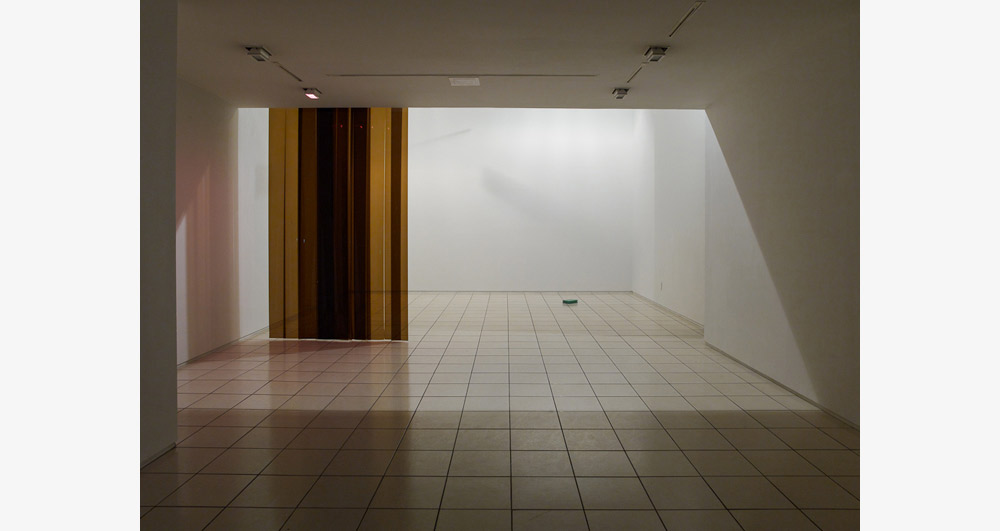
REY AKDOGAN
Fluorescent lighting, open window, magnets, tape, lighting gel #77. Considering that New York-based artist Rey Akdogan’s recent transformation of a second-floor room at MoMA PS1 was mainly the result of her placement of these pre-existing elements and others, some of the words that might be used to describe it—sculpture, or installation—suggest an exhibition betraying more evidence of the artist’s hand than the one visitors encountered. The visual obsolescence of the materials themselves within the space created an ideally neutral setting for the sums of their parts: the breeze from the open window plus the metallic fringe attached to a low-lying hospital privacy screen sparked a shimmering ballet in miniature, and the red film applied to part of a windowpane inspired a sunlit display of red and white forms that sharpened, blurred, and disappeared. The seemingly left-behind construction films and lighting gels played a more prominent role in the gallery than they do in the films and commercial photographs in which they aid in creating visual effects; at PS1, the viewer encountered them directly, right in the exhibition space. These displaced, unassuming materials were not only repurposed toward a less cinematic, more space-oriented experience; they were given a starring role. The result of their arrangement was a carefully balanced harmony between space, objects and, not incidentally, sunlight, the absence of which is key to the artist’s recently opened exhibition at Miguel Abreu Gallery on New York’s Lower East Side.
The first remarkable aspect of Akdogan’s show at Miguel Abreu, entitled “Night Curtain,” is that it is open to visitors not during regular gallery hours, but from dusk to midnight. Arriving at almost-dusk under a dark blue but not altogether black sky, I met with a pair of locked glass doors beyond which I could make out a vinyl curtain and large shadows moving across a white wall. When the doors were opened, I first encountered Carousel # 1 (2010-2012), a slide show featuring eighty medium painting-sized abstractions—some simple in color range and composition, others deliciously intricate—made by the non-photographic process of pressing lighting gels, Cinefoil, and colored packaging materials between slide frames (something about the whir and clack of the projector and the captivating images produced by seemingly half-intentional, half-arbitrary efforts evoked science class). In the context of Akdogan’s exhibition, the projections seem to be more about what can happen when these scraps are isolated and exposed to light than about the artist’s process. Though Akdogan does compose the slides, the degree of intentionality in their authorship remains a mystery. Here, these scraps are elevated to nuanced visions from a primary-colored otherworld, hard-edged blue on one slide, fuzzy or celestial on the next.
Further into the gallery space hangs the translucent, amber-colored PVC strip curtain I had glimpsed from outside, as well as a modified industrial ceiling fan powering a soft breeze through the space. These elements, taken together with engineered lighting, a small stack of sandblasted glass diffusers on the floor, and several detached aluminum fan blades leaning against a wall, are Artikelgruppe (2012), the show’s centerpiece. Observing these elements, it would be possible to misconstrue Akdogan’s work as ready-made, or as a more hands-off, more industrial Arte Povera. But these items, bulbs and fragments, though very apparent in the Abreu space compared with the materials’ more neutral presence at PS1, are still only relevant means to an end. Though these normally background attendants of light and air are present as artwork, their main concerns here are still lighting and cooling. The reward for viewers is not in these materials, it is in the multi-sensory, kinetic, layered experience that the materials have been re-contextualized and modified to create. After dark, without the interference of sunlight and most likely without the presence of other gallery-goers, the heightened effects of an artificial breeze and looming shadows can be all the more surreal. What viewers may take away from Akdogan’s work is absolutely nothing. But they may also feel an impression of serene balance between materials cultivated to both recede into and transform space, resulting in gradually unfolding experiences with a lasting impact.
Rey Akdogan’s “Night Curtain” is on view through October 14 at Miguel Abreu Gallery, 36 Orchard Street, New York.
Image courtesy of the artist and Miguel Abreu Gallery, New York.

















